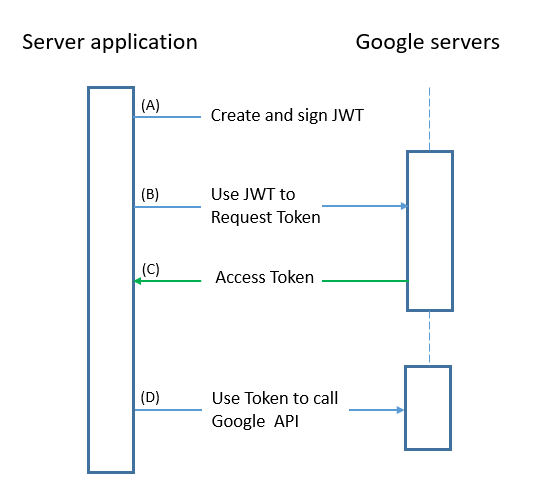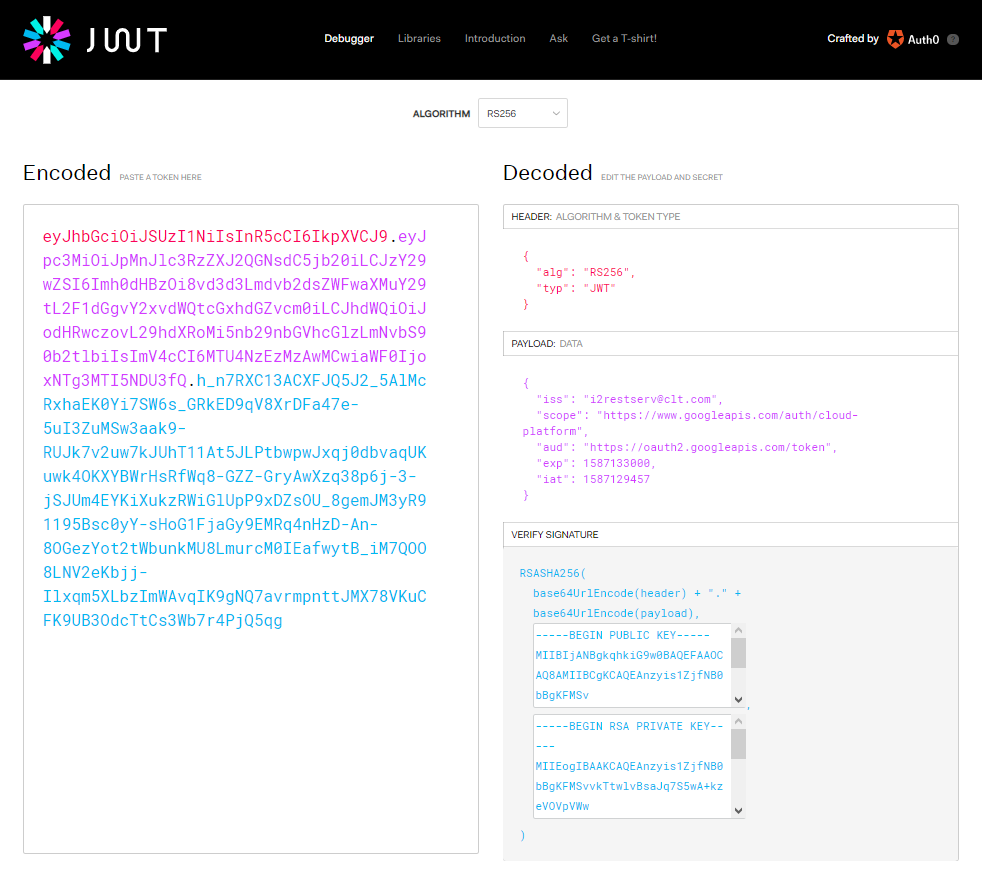Difference between revisions of "NoAuth usecase 4"
Pavel.lobko (talk | contribs) |
Pavel.lobko (talk | contribs) |
||
| Line 6: | Line 6: | ||
[[File:Google-serv-to-serv.png|400px]]<br> | [[File:Google-serv-to-serv.png|400px]]<br> | ||
| − | A)Create a JSON Web Token (JWT, pronounced, "jot") which includes a header, a claim set, and a signature.<br> | + | A) Create a JSON Web Token (JWT, pronounced, "jot") which includes a header, a claim set, and a signature.<br> |
| − | B)Request an access token from the Google OAuth 2.0 Authorization Server.<br> | + | B) Request an access token from the Google OAuth 2.0 Authorization Server.<br> |
| − | C)Handle Authorization Server JSON response.<br> | + | C) Handle Authorization Server JSON response.<br> |
| − | D)Use token in api call<br> | + | D) Use token in api call<br> |
== Initial step == | == Initial step == | ||
Revision as of 12:55, 22 May 2020
When you need your application to call Google APIs on behalf of its own (no user data is accessing and user is not involved directly), you should refer to Google OAuth 2.0 for Server to Server Applications.
It is not exactly Oauth2 Client Credential flow, so i2Rest Client can't deal with it for you using existing built-in authentication flows.
But we still can reproduce this authorization scenario composing requests and handling responses manually.
Lets take a look on steps we should perform.

A) Create a JSON Web Token (JWT, pronounced, "jot") which includes a header, a claim set, and a signature.
B) Request an access token from the Google OAuth 2.0 Authorization Server.
C) Handle Authorization Server JSON response.
D) Use token in api call
Contents
Initial step
To perform server-to-(Google)server interactions you need a service account, which is an account that belongs to your application instead of to an individual end user. Your application will call Google APIs on behalf of the service account using service account credentials - a generated email address that is unique and at least one public/private key pair. We should go to Google API console and find this account details, because they are necessary at the next step.
JSON Web Token
Now we have to deal with JSON Web Token (JWT). JWT consists of two JSON objects - a header and a claim set, and a signature. All parts must be encoded using the Base64url encoding. Using JWT encoders like this one can save much time.
So lets compose our JWT using credentials prepared on the initial step and Google's instructions.

Token request
The next step is POST request on https://oauth2.googleapis.com/token with JWT as an URL encoded request body.
Note: you have to add Google.com SSL certificate CA to your DCM to perform https requests
I2REST COMMAND(*POST)
URL('https://oauth2.googleapis.com/token')
BODY(*N 'grant_type=urn%3Aietf%3Aparams%3Aoauth%3Agra
nt-type%3Ajwt-bearer&assertion=eyJhbGciOiJSUzI1N
iIsInR5cCI6IkpXVCJ9.eyJpc3MiOiJpMnJlc3RzZXJ2QGNs
aWVudC1mbG93LWV4YW1wbGUuaWFtLmdzZXJ2aWNlYWNjb3Vu
dC5jb20iLCJzY29wZSI6Imh0dHBzOi8vd3d3Lmdvb2dsZWFw
aXMuY29tL2F1dGgvY2xvdWQtcGxhdGZvcm0iLCJhdWQiOiJo
dHRwczovL29hdXRoMi5nb29nbGVhcGlzLmNvbS90b2tlbiIs
ImV4cCI6MTU4NzEzMzAwMCwiaWF0IjoxNTg3MTI5NDU3fQ.h
_n7RXC13ACXFJQ5J2_5AlMcRxhaEK0Yi7SW6s_GRkED9qV8X
rDFa47e-5uI3ZuMSw3aak9-RUJk7v2uw7kJUhT11At5JLPtb
wpwJxqj0dbvaqUKuwk4OKXYBWrHsRfWq8-GZZ-GryAwXzq38
p6j-3-jSJUm4EYKiXukzRWiGlUpP9xDZsOU_8gemJM3yR911
95Bsc0yY-sHoG1FjaGy9EMRq4nHzD-An-8OGezYot2tWbunk
MU8LmurcM0IEafwytB_iM7QOO8LNV2eKbjj-Ilxqm5XLbzIm
WAvqIK9gNQ7avrmpnttJMX78VKuCFK9UB3OdcTtCs3Wb7r4P
jQ5qg' 'application/x-www-form-urlencoded')
OUTPUT(*BOTH)
DCMCLIENT(MYCLIENT)
RECVLOG('/home/btpl/rejwt.log')
SENTLOG('/home/btpl/sejwt.log')
AUTHMETHOD(*NONE)
Handling Authorization Server response
If we composed JWT and access token request correctly, Authorization Server will respond with an access token.
Server response (status 200, shown 261 bytes of 261):
{"access_token":"ya29.c.Ko8BxwcD_TDznwIQVB7Y_vs1S8a86_DhMfVwz1rcMfLkaMkMtx
BBIxqoYbfJdQvp5O3EONN-lz7VviAVNWx3pQInTxPdf_2pmL9JW3l8Qt
DfSrfVL0CSk1j_BgEdR0jkPCCsRQPtWkSdSm-cH2vFZZiVcOOEOq4Yt8C3jzBl3kzNt2N882ic
P0G6vmwdFljOdhY","expires_in":3599,"token_type":"Bearer"}
Authorized API call
Now it's time to call an API. As an example we will create Google service account with IAM API and appropriate method. Access token will be attached using the access_token query string parameter.
I2REST COMMAND(*POST)
URL('https://iam.googleapis.com/v1/projects/client-fl
ow-example/serviceAccounts?access_token=ya29.c.Ko
8BxwcD_TDznwIQVB7Y_vs1S8a86_DhMfVwz1rcMfLkaMkMtxB
BIxqoYbfJdQvp5O3EONN-lz7VviAVNWx3pQInTxPdf_2pmL9J
W3l8QtDfSrfVL0CSk1j_BgEdR0jkPCCsRQPtWkSdSm-cH2vFZ
ZiVcOOEOq4Yt8C3jzBl3kzNt2N882icP0G6vmwdFljOdhY')
BODY(*N '{ "accountId": "i2restcreated",
"serviceAccount": {
"description": "created via i2rest client",
"displayName": "example one" }
}' 'application/json' *YES 1208)
OUTPUT(*BOTH)
DCMCLIENT(MYCLIENT)
RECVLOG('/home/btpl/recreatsr1.log')
SENTLOG('/home/btpl/sncreatsr1.log')
AUTHMETHOD(*NONE)
Let's check if account was created with another request to list method of the same API. At this time we will attach access token as an additional header, which is a preferred option.
I2REST COMMAND(*GET)
URL('https://iam.googleapis.com/v1/projects/client-fl
ow-example/serviceAccounts')
HEADERS((AUTHORIZATION 'Bearer ya29.c.Ko8BxwcD_TDznwI
QVB7Y_vs1S8a86_DhMfVwz1rcMfLkaMkMtxBBIxqoYbfJ
dQvp5O3EONN-lz7VviAVNWx3pQInTxPdf_2pmL9JW3l8Q
tDfSrfVL0CSk1j_BgEdR0jkPCCsRQPtWkSdSm-cH2vFZZ
iVcOOEOq4Yt8C3jzBl3kzNt2N882icP0G6vmwdFljOdhY
'))
OUTPUT(*BOTH)
DCMCLIENT(MYCLIENT)
RECVLOG('/home/btpl/CAdriverecv.log')
SENTLOG('/home/btpl/CAdrivesent.log')
AUTHMETHOD(*NONE)
And here is server respond showing us that both requests were successfull:
"accounts": [
{
"name": "projects/client-flow-example/serviceAccounts/i2restserv@client-flow-example.iam.gserviceaccount.com",
"projectId": "client-flow-example",
"uniqueId": "117967955212758073044",
"email": "i2restserv@client-flow-example.iam.gserviceaccount.com",
"displayName": "i2restserv",
"etag": "MDEwMjE5MjA=",
"description": "Example to i2rest client flow",
"oauth2ClientId": "117967955212758073044"
},
{
"name": "projects/client-flow-example/serviceAccounts/i2restcreated@client-flow-example.iam.gserviceaccount.com",
"projectId": "client-flow-example",
"uniqueId": "104934312932229503067",
"email": "i2restcreated@client-flow-example.iam.gserviceaccount.com",
"displayName": "example one",
"etag": "MDEwMjE5MjA=",
"description": "created via i2rest client",
"oauth2ClientId": "104934312932229503067"
}
]